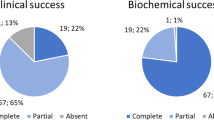Abstract
Background
Primary hyperaldosteronism caused by an aldosterone-producing adenoma of the adrenal gland is regarded as the most common type of endocrine hypertension. The aim of this study was to analyze the changing pattern of the intraoperative blood pressure during endoscopic adrenalectomy recorded in patients with Conn’s syndrome compared to patients with hormone-inactive incidentaloma and its possible influence by the surgical approach.
Methods
From February 1994 to March 2004, 40 patients underwent endoscopic adrenalectomy for Conn’s syndrome. All patients had arterial hypertension over a median period of 84 (5–240) months and were pretreated with an aldosterone antagonist in 76.3% and with specific antihypertensive medication in 85%. Over the same period of time, endoscopic adrenalectomy was carried out in 80 patients with incidentaloma. Of these, 41 (53.2%) displayed arterial hypertension requiring drug therapy.
Results
The adrenal gland was resected using the retroperitoneal in 25 and the transperitoneal approach in 15 patients with Conn’s syndrome. Conversion to an open procedure was required in two patients. Intraoperative increases in blood pressure necessitating antihypertensive therapy were observed in 17 of 40 patients (44.7%), in 11 of 40 patients (28.9%) blood pressure peaks of >200 mmHg (> 1 min) were noted. Differences between the preoperative and maximum intraoperative blood pressure were significant for the retroperitoneal approach only (systolic: p = 0.0001; diastolic: p = 0.0005), but not for the transperitoneal technique. The increase in intraoperative blood pressure in patients with Conn’s syndrome was significantly higher, for both systolic (p < 0.0001) and diastolic (p = 0.0037) readings, compared to that in patients with incidentaloma undergoing endoscopic adrenalectomy during the same period of time.
Conclusion
Our results demonstrate that relevant intraoperative increases in blood pressure occur in patients with Conn’s syndrome despite prior therapy with an aldosterone antagonist, necessitating specific precautionary measures during anesthesia. Intraoperative blood pressure was significantly higher for the retroperitoneal than for the transperitoneal procedure, which leads us to advocate the latter approach for endoscopic adrenalectomy.
Similar content being viewed by others
References
Bonjer HJ, Berends FJ, Kazemier G, Steyerberg EW, de Herder WW, Bruining HA (2000) Endoscopic retroperitoneal adrenalectomy: lessons learned from 111 consecutive cases. Ann Surg 232: 796–803
Duncan III JL, Fuhrman GM, Bolton JS, Bowen JD, Richardson WS (2000) Laparoscopic adrenalectomy is superior to an open approach to treat primary hyperaldosteronism. Am Surg 66: 932–936
Fernández-Cruz L, Saenz A, Benarroch G, Astudillo E, Taurá P, Sabater L (1996) Laparoscopic unilateral and bilateral adrenalectomy for Cushing’s syndrome: transperitoneal and retroperitoneal approaches. Ann Surg 224: 727–734
Funder JW, (1997) Aldosterone, salt and cardiac fibrosis. Clin Exp Hypert 19: 885–899
Gockel I, Kneist W, Heintz A, Beyer J, Junginger Th (2005) Endoscopic adrenalectomy: Analysis of the transperitoneal and retroperitoneal approach — results of a prospective follow–up study. Surg Endosc 19: 569–573
Heintz A, Junginger Th, Böttger T (1995) Retroperitoneal adrenalectomy. Br J Surg 82: 215
Heintz A, Strecker U, Walgenbach S, Junginger Th (1997) Ergebnisse der endoskopischen, retroperitonealen Adrenalektomie unter besonderer Berücksichtigung des intraoperativen Verlaufs. Chirurg 68: 154–158
Irony I, Kater CE, Biglieri EG, Shackleton CHL (1990) Correctable subsets of primary aldosteronism: primary adrenal gland hyperplasia and renin responsive adenoma. Am J Hypertens 3: 576–582
Kneist W, Vetter G, Kann P, Jaursch-Hancke, Heintz A, Hommel G, Junginger Th (2004) Transperitoneale oder retroperitoneale Adrenalektomie. Ergebnisse einer prospektiven Verlaufsbeobachtung. Chirurg 75: 1098–1103
Magill SB, Raff H, Shaker JL, Brickner RC, Knechtges TE, Kehoe ME, Findling JW (2001) Comparison of adrenal vein sampling and computed tomography in the differentiation of primary aldosteronism. J Clin Endocrinol Metab 86: 1066–1071
Meria P, Kempf BF, Hermieu JF, Plouin PF, Duclos JM (2003) Laparoscopic management of primary hyperaldosteronism: clinical experience with 212 cases. J Urol 169: 32–35
Sawka AM, Young WF, Thompson GB, Grant CS, Parley DR, Leibson C, van Heerden JA (2001) Primary aldosteronism: factors associated with normalization of blood pressure after surgery. Ann Intern Med 135: 258–261
Shen WT, Lim RC, Siperstein AE, Clark OH, Schecter WP, Hunt TK, Horn JK, Duh QY (1999) Laparoscopic versus open adrenalectomy for the treatment of primary hyperaldosteronism. Arch Surg 134: 628–631
Shipton EA, Hugo JM (1982) Primary aldosteronism and its importance to the anaesthesist. S Afr Med J 62: 60–63
Siren J, Haglund C, Huikuri K, Sivula A, Haapiainen R (1999) Laparoscopic adrenalectomy for primary aldosteronism: clinical experience in 12 patients. Surg Laparosc Endosc 9: 9–13
Sunman W, Rothwell M, Sever PS (1992) Conn’s syndrome can cause malignant hypertension. J Hum Hypertens 6: 75–76
Takeda M, (2000) Laparoscopic adrenalectomy: transperitoneal versus retroperitoneal approaches. Biomed Phamacother 54(Suppl 1): 207s–210s
Takeda M, Go H, Imai T, Nishiyama T, Morishita H (1994) Laparoscopic adrenalectomy for primary aldosteronism: report of initial ten cases. Surgery 115: 621–625
Wheeler MH, Harris DA (2003) Diagnosis and management of primary aldosteronism. World J Surg 27: 627–631
Young WF Jr, (2003) Minireview: Primary aldosteronism—changing concepts in diagnosis and treatment. Endocrinology 144: 2208–2213
Author information
Authors and Affiliations
Corresponding author
Additional information
An erratum to this article is availbale at http://dx.doi.org/10.1007/s00464-005-3004-2.
Rights and permissions
About this article
Cite this article
Gockel, I., Heintz, A., Kentner, R. et al. Changing pattern of the intraoperative blood pressure during endoscopic adrenalectomy in patients with Conn’s syndrome. Surg Endosc 19, 1491–1497 (2005). https://doi.org/10.1007/s00464-004-2286-0
Received:
Accepted:
Published:
Issue Date:
DOI: https://doi.org/10.1007/s00464-004-2286-0




